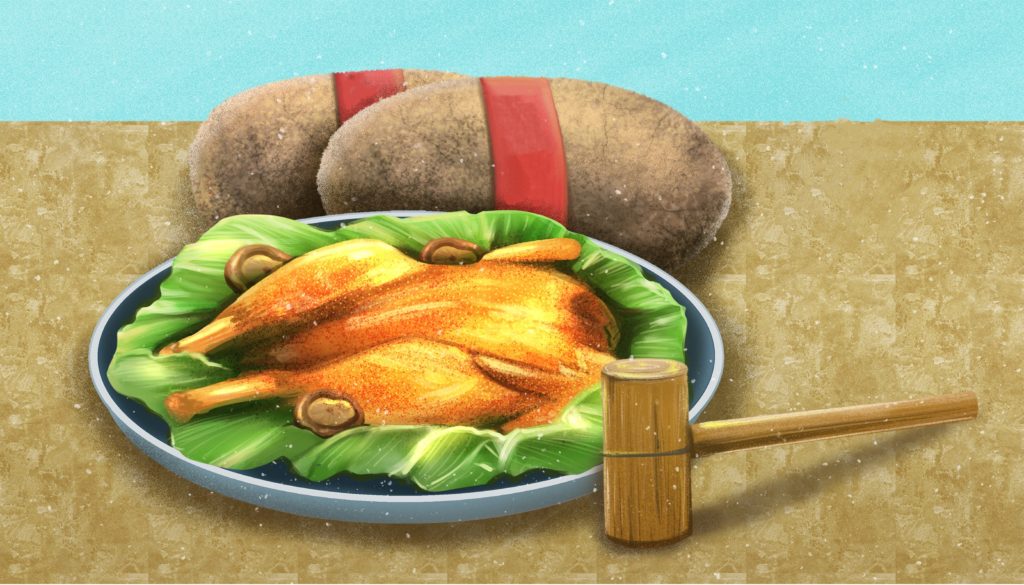Páo (炮) in Chinese means to wrap the meat in plant leaves (like lotus leaves, banana leaves, and reed) then paste clay all around it and bake it over a fire. When it is done, remove the clay crust and cut up the meat before serve. 炮 is an interesting character. The left part indicates fire. And the right part means bag, also means to cover or enclose something in material. Together they vividly depict the essence of the cooking technique.
History of the Pao Cooking Technique
Based on literary evidence, Páo as a cooking technique dates back at least to the 8th century BCE. Shijing (《诗经》), the Classic of Poetry also called the Book of Songs, is the oldest existing collection of Chinese poetry, comprising works dating from the 11th to the 6th centuries BCE. One of the poems describes how a host prepared rabbit meat for his guests. The rabbit meat was cooked in a variety of ways. One was to wrap a rabbit with clay while fur was still on and roast on fire.
During the Warring States period(c.475-221 BCE), Qu Yuan (屈原 c. 340–278 BCE), the great patriot that was celebrated for the Duanwu Festival, describes lamb cooked in clay was offered along with sugar cane juice as sacrifice to summon the soul of the deceased.

Liji (《礼记》), the Book of Rites, complied in the 1st century CE, describes the social forms and ceremonial rites of the Zhou dynasty(c. 1046 BC – 256 BC). It records a recipe of cooking suckling-pig by using the technique of Páo.
“For the Páo, they took a suckling-pig, had cut it open and removed the entrails, filled the belly with dates. They then wrapped it around with straw and reeds, which they plastered with clay, and baked it on fire. When the clay was all dry, they broke it off.” The pig was then fried and slow-cooked in soup for three days and nights before served.
This cooking technique was also recorded in the earliest Chinese medical writing, Recipes for Fifty-Two Ailments(《五十二病方》). It was buried in a tomb in 168 BCE under the Han dynasty but the actual date of writing might have dated earlier. The text presents more than 250 cures for ailments such as warts, hemorrhoids, and snake bites. The prescription it recommends for treating hemorrhoids is interesting but wired.

“Choke a yellow hen with soy paste and let it die. Wrap it in miscanthus leaves. Daub wet clay over it and bake it in the fire. When the crust is dry (and well done), eat the chicken. Use the feathers to fumigate the anus.”
I don’t know how effective the prescription is, but the prescription might be the world’s oldest recipe for clay-wrapped chicken, which is better known today as beggar’s chicken.
How Did Beggar’s Chicken Get Its Name?
There are several legends about the origins of beggar’s chicken. The most common one is that a beggar caught a chicken in the wild. He wanted to cook the chicken, but didn’t have any pots and condiments on hand. Disappointed, he looked down and saw the soil under his feet and suddenly had an idea. He then killed the chicken, removed the internal organs, and covered the it with mud. He dug a pit, made a fire, and roasted the chicken over the fire. When the mud was dried, he cracked it open and found that the chicken feathers came off along with the mud. The chicken was done, tender and juicy.

Another legend involves the Emperor Qianlong (乾隆皇帝) of the Qing Dynasty (1644–1911 CE).
When the emperor traveled to Jiangnan (which referred to the south of the lower reaches of the Yangtze River) in the late 18th century, he was lost in the wild, and a beggar gave him a cooked chicken which he considered a delicacy. The hungry emperor found the chicken so delicious that he even introduced it to royal cuisine after he returned to his palace. Since the name “beggar’s chicken” was somewhat embarrassing, it was renamed as the wealthy’s chicken. This is why it’s called the wealthy’s chicken in some places.
How to Make Beggar’s Chicken at Home?
Beggar’s Chicken Recipe
- Services: 5-8 People
- Prep Time: 2 days
- Cook Time: 3 hours
Ingredients
- A 4-5 pound whole chicken
- 2 lotus or banana leaves
- 1 tbsp light soy sauce
- 1 tbsp dark soy sauce
- 2 tbsp Chinese cooking (Shaoxing) wine
- 1 tsp five-spice powder
- 1 tbsp salt
- 1 tbsp minced garlic
- 1 tbsp minced ginger
- 1 tbsp minced green onion
- 8-10 dried shiitake mushrooms
- 2 stalks of green onion
- 5-8 garlic cloves
- 3 small chunks of ginger
- 2 cinnamon sticks
- 3 whole star anise
- 3 bay leaves
- 3lb nontoxic ceramic clay*
- Kitchen String
Marinade
Stuffing
Crust
Note:
*I suggest you wrap the chicken and the leaves with aluminum foil before you apply the clay. The clay is likely to be non-toxic but adding the aluminum foil can prevent unknown chemicals in the clay from contaminating the chicken.
Instructions
- Clean the chicken under tap water; allow to drain thoroughly. Soak the dried shiitake mushrooms in hot water.
- Make the marinade. In a small bowl, add light soy sauce, dark soy sauce, cooking wine, salt, minced garlic, ginger, and green onion, and five-spice powder. Mix the ingredients together until you have a paste consistency.
- Marinate the chicken. Spread the sauce all over the chicken, including the wings and legs. Loosen the breast skin, and brush the marinade sauce under the skin.
- Cover the bowl and refrigerate the chicken overnight.
- Prepare the lotus/banana Leaves. If you use dried lotus leaves, soak them in hot water for at least an hour before use. If you use banana leaves then let them thaw at room temperature, wash them, and pat dry with paper towel or dry cloth.
- Remove chicken from marinade. Rub the chicken cavity with the marinade. Drain the mushrooms. Fill the cavity with mushroom, green onion, garlic, ginger, bay leaves, cinnamon sticks, and star anises. Close the opening with tooth picks, pull in the legs and tie them together with kitchen string.
- Place the chicken on the top of one lotus/banana leaf. Pull in the wings. Tie the leaf around the chicken. Then add the second leaf and cover up the whole chicken. Secure the leaves in place with kitchen string.
- Cover the whole chicken with two pieces of aluminum foil, one from the bottom and another from the top.
- Make two pieces of clay that are wide enough to cover the chicken, each piece is about half centimeter. Place the wrapped chicken in the center of one flattened clay and lay the other one over the top of the chicken. Seal the edges of the clay by pressing it closed with your fingers.
- Preheat oven to 350, and bake for about 3 hours.
- Remove from the oven and rest for about 20 minutes before you open it.
- Crack open the clay with a hammer. Unwrap the chicken and enjoy!